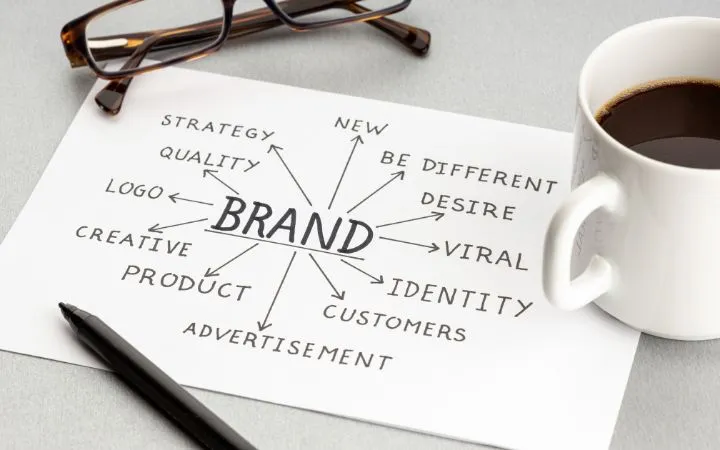
Creating a Brand in 2024: Your Essential Guide
In today's fast-paced world, building a brand that stands out and resonates with your audience is more crucial than ever. As we look towards 2024, the landscape of branding continues to evolve, requiring a strategic mix of creativity, technology, and insight to connect with target markets effectively. Here, we delve into the art of creating a compelling brand in 2024, incorporating practical applications and visual elements that bring your brand's unique identity to life.
Key Takeaways
- Target Audience: Understanding your audience is the bedrock of brand creation.
- Brand Identity: Crafting a distinct brand identity sets you apart.
- Visual Representation: Logo and design are key to memorability.
- Packaging: Creative packaging offers functional brand representation.
- Labelling: Strategic labelling communicates brand values and product information.
- Delivery: Ensuring products arrive in style reinforces brand reliability.
- Beyond the Product: Expanded content labels offer further branding opportunities.
- Sustainability: Eco-friendly practices are a must for modern brands.
- Technology Integration: Leveraging technology enhances brand engagement.
Understanding Your Audience
Identifying your ideal customers through market research and creating buyer personas is the first step towards building a brand that not only speaks to its audience but also deeply resonates with their needs and preferences. It's not just about who your audience is but understanding their world, their challenges, aspirations, and how your brand can become a meaningful part of their lives.
Consider the following aspects when researching your target audience:
- Demographics: Age, gender, income, location, education, and occupation.
- Psychographics: Interests, attitudes, values, and lifestyle.
- Behaviour: Purchase habits, brand interactions, and decision-making processes.
- Needs and Pain Points: Challenges they face and how your brand can provide solutions.
By gaining a comprehensive understanding of your audience, you can tailor your brand messaging, visuals, and offerings to effectively capture their attention and foster a strong connection.
Crafting Your Brand Identity
Your brand identity is more than just a logo; it's the embodiment of your values, mission, and the personality conveyed across all channels. It encompasses your brand name, tone of voice, visual elements, and the overall experience you provide to your customers.
Directly applying this identity through Labels ensures your first impression lasts. Labels serve as a powerful tool to communicate your brand story, values, and key information about your products.
Consider the following elements when developing your brand identity:
- Brand Name: Choose a name that is memorable, meaningful, and reflects your brand's essence.
- Logo: Create a visually compelling logo that encapsulates your brand's personality and values.
- Colour Palette: Select colours that evoke the desired emotions and align with your brand's character.
- Typography: Choose fonts that are legible, distinctive, and reinforce your brand's tone.
- Brand Voice: Define your brand's tone and communication style to ensure consistency across all touchpoints.
Consistency is key when applying your brand identity. Ensure that all your marketing materials, packaging, and customer interactions align with your established brand guidelines to create a cohesive and recognisable brand experience.

Visual Representation
The power of visual elements like logos, colours, and fonts cannot be understated. They make your brand memorable and help establish an emotional connection with your audience. Your visual identity should be distinctive, consistent, and reflective of your brand's personality.
Using Folding Boxes, for example, showcases your brand design and information effectively on retail shelves. Folding boxes provide ample space to display your logo, brand colours, and key product details, making them an excellent tool for brand visibility and recognition.

Consider the following tips when designing your visual brand elements:
- Logo Versatility: Ensure your logo looks great in various sizes, colours, and applications.
- Colour Psychology: Choose colours that evoke the desired emotions and associations with your brand.
- Typography Hierarchy: Use different font sizes, weights, and styles to create visual hierarchy and guide the reader's eye.
- Imagery: Select images that align with your brand's aesthetic and communicate your message effectively.
- Consistency: Maintain a consistent visual style across all touchpoints to reinforce brand recognition.
Packaging Your Product
The significance of packaging goes beyond aesthetics; it's your brand's physical representation in the hands of customers. It offers an opportunity to create a tangible connection with your audience and leave a lasting impression. Creative yet functional packaging solutions can set your brand apart and appeal to consumers' preferences.
Pouch Packaging is a versatile and innovative option that allows for eye-catching designs and practical features. From stand-up pouches to resealable bags, pouch packaging offers convenience, portability, and ample branding space.
Consider the following aspects when designing your product packaging:
- Material Choice: Select materials that align with your brand values, such as sustainability or premium quality.
- Functionality: Ensure your packaging serves its purpose effectively, whether it's protecting the product or providing easy access.
- Design Elements: Incorporate your brand colours, logo, and visuals prominently on the packaging.
- Information Hierarchy: Highlight key product information, such as name, benefits, and usage instructions, in a clear and organised manner.
- Shelf Impact: Consider how your packaging will stand out on store shelves and grab consumers' attention.

Labelling for Brand Communication
Effective labelling goes beyond the basics of product information; it's a powerful tool for brand communication. Labels provide an opportunity to convey your brand's story, values, and unique selling points directly on your products.

Multi-Layer Labels offer expanded space for branding and product details. By incorporating multiple pages or peel-off sections, you can provide in-depth information, promotional content, or user instructions without compromising on design aesthetics.
Consider the following labelling strategies to enhance your brand communication:
- Brand Story: Use labels to share your brand's history, mission, and values, creating a deeper connection with consumers.
- Product Benefits: Highlight the key benefits and unique features of your products to differentiate them from competitors.
- Regulatory Information: Ensure your labels comply with relevant regulations, such as ingredient lists, allergen warnings, and safety instructions.
- Interactive Elements: Incorporate QR codes, augmented reality, or other interactive features to engage customers and provide additional content.
- Personalisation: Explore opportunities for personalised labels, such as custom names or messages, to create a unique and memorable experience for customers.
Delivering Your Product
The delivery experience can significantly impact your brand's reliability and image. It's the final touchpoint in the customer journey and can leave a lasting impression on their perception of your brand. Customised Shipping Boxes serve as the final touchpoint in a series of brand interactions, reinforcing the quality and care your brand represents.
Consider the following aspects when designing your shipping boxes:
- Brand Consistency: Ensure your shipping boxes align with your overall brand identity, incorporating your logo, colours, and visual elements.
- Protection: Choose materials and box sizes that adequately protect your products during transit.
- Unboxing Experience: Create a memorable unboxing experience by including branded tissue paper, custom inserts, or personalised notes.
- Sustainability: Opt for eco-friendly materials and minimalist packaging to demonstrate your commitment to sustainability.
- Return Management: Include clear return instructions and labels to simplify the process for customers.

Beyond the Product
Expanded content labels provide additional branding opportunities through instructional content, further engaging customers and contributing to a comprehensive brand experience. Booklet Labels allow you to include detailed product information, usage guides, or promotional content in a compact and accessible format.
Consider the following ways to leverage booklet labels for enhanced branding:
- Brand Storytelling: Share your brand's history, values, and mission through engaging narratives or infographics.
- Product Education: Provide in-depth information about your products, including ingredients, benefits, and usage instructions.
- Cross-Promotion: Highlight related products or upcoming releases to encourage further engagement with your brand.
- Customer Testimonials: Include customer reviews or success stories to build trust and credibility.
- Localisation: Create multilingual booklet labels to cater to different markets and demonstrate cultural sensitivity.
Sustainability: A Key Pillar of Modern Branding
In the branding landscape of 2024, sustainability is no longer an option but a necessity. Consumers are increasingly conscious of the environmental impact of their purchases, and they seek brands that align with their eco-friendly values. Incorporating sustainable practices into your branding strategy not only contributes to a greener future but also resonates with environmentally-minded customers.
Consider the following ways to embrace sustainability in your branding:
- Eco-Friendly Packaging: Choose biodegradable, recyclable, or compostable packaging materials to minimise waste and demonstrate your commitment to the environment.
- Sustainable Sourcing: Partner with suppliers who adhere to sustainable and ethical practices, and communicate this transparently to your customers.
- Carbon Footprint Reduction: Implement measures to reduce your brand's carbon footprint, such as optimising transportation, using renewable energy, or offsetting emissions.
- Circular Economy: Explore opportunities to create closed-loop systems, where products can be reused, repaired, or recycled, promoting a circular economy.
- Sustainability Education: Use your brand platform to educate customers about sustainable practices and encourage them to make environmentally-friendly choices.
By integrating sustainability into your branding strategy, you demonstrate your commitment to responsible business practices and attract customers who prioritise eco-consciousness.
Leveraging Technology for Brand Engagement
In the digital age, technology offers unparalleled opportunities for brands to engage with their audiences in innovative and immersive ways. By leveraging cutting-edge technologies, you can create memorable brand experiences that foster deeper connections with your customers.
Consider the following technological avenues for brand engagement:
- Augmented Reality (AR) Packaging: Incorporate AR elements into your packaging to provide interactive product demonstrations, virtual try-ons, or immersive brand storytelling experiences.
- QR Codes: Utilise QR codes on your labels and packaging to direct customers to additional content, such as product information, video tutorials, or exclusive promotions.
- Personalisation through Data Analytics: Leverage customer data and analytics to create personalised product recommendations, targeted promotions, and customised brand experiences.
- Social Media Integration: Encourage user-generated content and social media sharing by incorporating branded hashtags, challenges, or contests into your packaging and labels.
- Smart Packaging: Explore the possibilities of smart packaging, such as NFC tags or sensors, to provide product authentication, traceability, or real-time information to customers.
By embracing technology in your branding efforts, you can create engaging and interactive experiences that set your brand apart and foster customer loyalty.
Conclusion: Navigating the Branding Landscape of 2024
Creating a compelling brand in 2024 requires a strategic approach that combines audience understanding, distinct brand identity, creative packaging and labelling, sustainable practices, and technological integration. By meticulously incorporating these elements into your branding strategy, you can establish a strong and memorable brand presence that resonates with your target audience.
Remember, every touchpoint with your customer is an opportunity to reinforce your brand's values, personality, and unique selling points. From the initial brand discovery to the unboxing experience and beyond, ensure consistency and coherence in your branding efforts.
As you embark on your branding journey in 2024, consider partnering with experienced professionals who can guide you through the process and provide innovative solutions tailored to your brand's needs. At Labelprint24, we offer a wide range of branding services, including label printing, packaging design, and sustainable materials, to help you create a brand that stands out in the competitive landscape.
Embrace the power of branding in 2024 and let your brand's unique identity shine through every aspect of your customer's experience. With a strong brand foundation and a commitment to innovation, you can navigate the branding landscape of 2024 with confidence and success.




